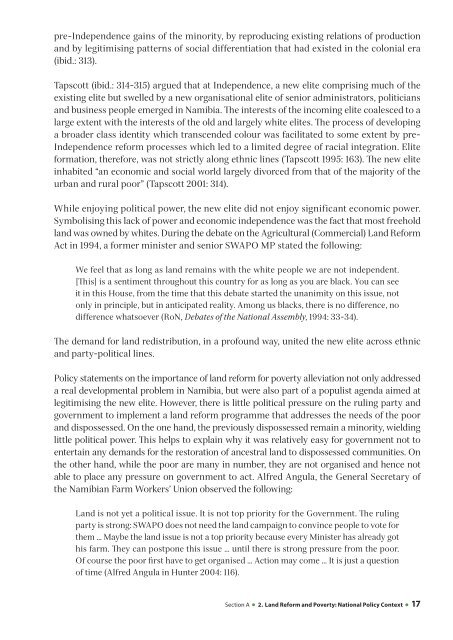Namibia country report
Namibia country report
Namibia country report
- No tags were found...
Create successful ePaper yourself
Turn your PDF publications into a flip-book with our unique Google optimized e-Paper software.
pre-Independence gains of the minority, by reproducing existing relations of productionand by legitimising patterns of social differentiation that had existed in the colonial era(ibid.: 313).Tapscott (ibid.: 314-315) argued that at Independence, a new elite comprising much of theexisting elite but swelled by a new organisational elite of senior administrators, politiciansand business people emerged in <strong>Namibia</strong>. The interests of the incoming elite coalesced to alarge extent with the interests of the old and largely white elites. The process of developinga broader class identity which transcended colour was facilitated to some extent by pre-Independence reform processes which led to a limited degree of racial integration. Eliteformation, therefore, was not strictly along ethnic lines (Tapscott 1995: 163). The new eliteinhabited “an economic and social world largely divorced from that of the majority of theurban and rural poor” (Tapscott 2001: 314).While enjoying political power, the new elite did not enjoy significant economic power.Symbolising this lack of power and economic independence was the fact that most freeholdland was owned by whites. During the debate on the Agricultural (Commercial) Land ReformAct in 1994, a former minister and senior SWAPO MP stated the following:We feel that as long as land remains with the white people we are not independent.[This] is a sentiment throughout this <strong>country</strong> for as long as you are black. You can seeit in this House, from the time that this debate started the unanimity on this issue, notonly in principle, but in anticipated reality. Among us blacks, there is no difference, nodifference whatsoever (RoN, Debates of the National Assembly, 1994: 33-34).The demand for land redistribution, in a profound way, united the new elite across ethnicand party-political lines.Policy statements on the importance of land reform for poverty alleviation not only addresseda real developmental problem in <strong>Namibia</strong>, but were also part of a populist agenda aimed atlegitimising the new elite. However, there is little political pressure on the ruling party andgovernment to implement a land reform programme that addresses the needs of the poorand dispossessed. On the one hand, the previously dispossessed remain a minority, wieldinglittle political power. This helps to explain why it was relatively easy for government not toentertain any demands for the restoration of ancestral land to dispossessed communities. Onthe other hand, while the poor are many in number, they are not organised and hence notable to place any pressure on government to act. Alfred Angula, the General Secretary ofthe <strong>Namibia</strong>n Farm Workers’ Union observed the following:Land is not yet a political issue. It is not top priority for the Government. The rulingparty is strong: SWAPO does not need the land campaign to convince people to vote forthem … Maybe the land issue is not a top priority because every Minister has already gothis farm. They can postpone this issue … until there is strong pressure from the poor.Of course the poor first have to get organised … Action may come … It is just a questionof time (Alfred Angula in Hunter 2004: 116).Section Livelihoods A ● 2. Land after Reform Land and Reform: Poverty: <strong>Namibia</strong> National <strong>country</strong> Policy <strong>report</strong> Context (2010) ● 17
















